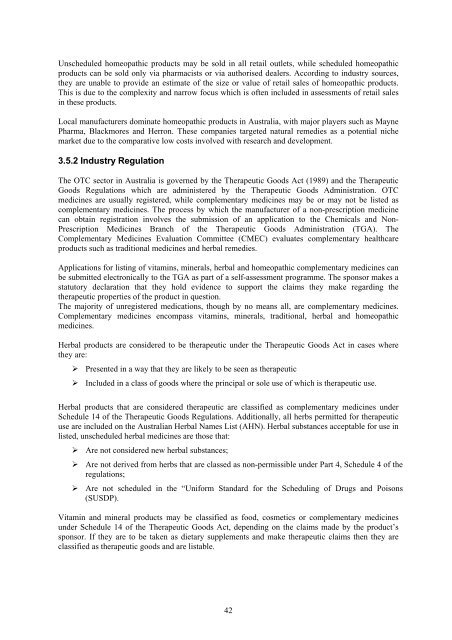Prospects for medicinal herbs - Bad Request
Prospects for medicinal herbs - Bad Request
Prospects for medicinal herbs - Bad Request
You also want an ePaper? Increase the reach of your titles
YUMPU automatically turns print PDFs into web optimized ePapers that Google loves.
Unscheduled homeopathic products may be sold in all retail outlets, while scheduled homeopathicproducts can be sold only via pharmacists or via authorised dealers. According to industry sources,they are unable to provide an estimate of the size or value of retail sales of homeopathic products.This is due to the complexity and narrow focus which is often included in assessments of retail salesin these products.Local manufacturers dominate homeopathic products in Australia, with major players such as MaynePharma, Blackmores and Herron. These companies targeted natural remedies as a potential nichemarket due to the comparative low costs involved with research and development.3.5.2 Industry RegulationThe OTC sector in Australia is governed by the Therapeutic Goods Act (1989) and the TherapeuticGoods Regulations which are administered by the Therapeutic Goods Administration. OTCmedicines are usually registered, while complementary medicines may be or may not be listed ascomplementary medicines. The process by which the manufacturer of a non-prescription medicinecan obtain registration involves the submission of an application to the Chemicals and Non-Prescription Medicines Branch of the Therapeutic Goods Administration (TGA). TheComplementary Medicines Evaluation Committee (CMEC) evaluates complementary healthcareproducts such as traditional medicines and herbal remedies.Applications <strong>for</strong> listing of vitamins, minerals, herbal and homeopathic complementary medicines canbe submitted electronically to the TGA as part of a self-assessment programme. The sponsor makes astatutory declaration that they hold evidence to support the claims they make regarding thetherapeutic properties of the product in question.The majority of unregistered medications, though by no means all, are complementary medicines.Complementary medicines encompass vitamins, minerals, traditional, herbal and homeopathicmedicines.Herbal products are considered to be therapeutic under the Therapeutic Goods Act in cases wherethey are:‣ Presented in a way that they are likely to be seen as therapeutic‣ Included in a class of goods where the principal or sole use of which is therapeutic use.Herbal products that are considered therapeutic are classified as complementary medicines underSchedule 14 of the Therapeutic Goods Regulations. Additionally, all <strong>herbs</strong> permitted <strong>for</strong> therapeuticuse are included on the Australian Herbal Names List (AHN). Herbal substances acceptable <strong>for</strong> use inlisted, unscheduled herbal medicines are those that:‣ Are not considered new herbal substances;‣ Are not derived from <strong>herbs</strong> that are classed as non-permissible under Part 4, Schedule 4 of theregulations;‣ Are not scheduled in the “Uni<strong>for</strong>m Standard <strong>for</strong> the Scheduling of Drugs and Poisons(SUSDP).Vitamin and mineral products may be classified as food, cosmetics or complementary medicinesunder Schedule 14 of the Therapeutic Goods Act, depending on the claims made by the product’ssponsor. If they are to be taken as dietary supplements and make therapeutic claims then they areclassified as therapeutic goods and are listable.42
















